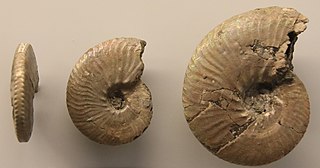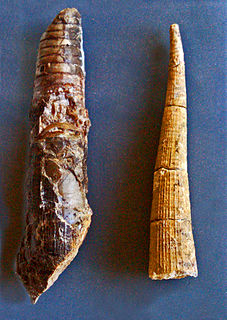
Goniatites is a genus of extinct cephalopods belonging to the family Goniatitidae, included in the superfamily Goniatitaceae. Hibernicoceras and Hypergoniatites are among related genera.

Australiceras is an extinct ammonite genus from the upper part of the Early Cretaceous, Aptian stage, included in the family Ancyloceratidae.
Aegoceras is an evolutionary wound ammonite, with wide spaced ribs, from the Early Jurassic (England) included in the Liparoceratidae and superfamily Eoderoceratidae. Related genera are Leparoceras and Beaniceras.
Anahamulina is an extinct ammonoid cephalopod genus from the Lower Cretaceous. Named by Hyatt, 1900, Anahamulina is included in the family Ptychoceratidae, which is part of the Turrilitaceae.

Anahoplites is a genus of rather involute, compressed hoplitid ammonites with flat sides, narrow flat or grooved venters, and flexious ribs or striae arising from weak umbilicle tubercles that end in fine dense ventrolateral nodes. The elements of their sutures are short, wide and jaggedy. Specimens of Annahoplites have diameters typically in the range of 4–6 centimetres (1.6–2.4 in) although some with diameters of as much as 19 centimetres (7.5 in) have been reported. The genus lived during the Cretaceous, from the Middle to the late Albian.

Argonauticeras is an extinct ammonoid cephalopod genus that lived during the latter part of the Early Cretaceous, included in the Lytoceratida and found in lower and possibly middle Aptian marine sediments. It has been thought of as a subgenus of Ammonoceratites.
Emileia is an extinct genus from a well-known class of fossil cephalopods, the ammonites, that lived during the early part of the Bajocian.
Oecotraustes is an extinct cephalopod genus included in the ammonid family Oppeliidae and named by Waagen in 1869. The genus lived during the Middle Jurassic.

Hyperlioceras is an extinct genus of cephalopod included in the ammonitid family Graphoceratidae that lived during the Bajocian stage of the Middle Jurassic. The type species is Hyperlioceras discites
Ogmodirus is an extinct genus of plesiosaur found in the Cenomanian-Turonian Greenhorn Limestone of Kansas. It may be member of the Elasmosauridae, a group of marine animals related to Elasmosaurus, but the condition of the fossils discovered to date means the genus is dubious beyond Plesiosauria. The type species, O. martini, was named by Samuel Wendell Williston and Roy L. Moodie in 1913. The original specimen consisted of a pelvic girdle, limb elements, and more than fifty cervical (neck) vertebrae discovered in Cloud County, Kansas. A second species, Ogmodirus ischiadicus, has since been referred to Styxosaurus. Sepkoski (2002) assigned Ogmodirus to the Plesiosauria.

Nostoceras is an extinct genus of ammonites. The etymology of the name Nostoceras comes from "nostos" meaning return and "ceros" meaning horn, named as such by Alpheus Hyatt because it bends back on itself.

Kionoceras is an extinct nautiloid cephalopod genus included in the orthocerid family Kionoceratidae with scattered worldwide distribution from the Middle Ordovician to the Lower Permian. Kionoceratids are orthocerids with prominent longitudinal ornamentation on their shells, sometimes augmented by secondary transverse ornamentation. Orthocerids are, of course, prehistoric nautiloides with generally straight and elongate shells, mostly with central or subcentral siphuncles.
Zittelloceras is an extinct genus of nauiloids from the order Oncocerida which are among a large group of once diverse and numerous shelled cephalopods, now represented by only a handful of species.

Clymeniida is an order of ammonoid cephalopods from the Upper Devonian characterized by having an unusual dorsal siphuncle. They measured about 4 cm (1.6 in) in diameter and are restricted to Europe, North Africa, and possibly Australia.

Gymnites is a genus of ammonoid cephalopod from the Middle Triassic belonging to the ceratitid family Gymnitidae. These nektonic carnivores lived during the Triassic period, Anisian age.

Ancyloceratidae is a family of heteromorphic ammonites that lived during the Early Cretaceous. Their shells begin as a loose spiral with whorls not touching which then turns into a straight shaft that ends in a J-shape hook or bend at end. Coarse ribbing and spines are common.

Belemnites is a genus of an extinct group of cephalopods belonging to the order Belemnitida. These cephalopods existed in the Early Jurassic period from the Hettangian age to the Toarcian age (175.6–183.0). They were fast-moving nektonic carnivores.
Melchiorites is a desmoceratid ammonite genus included in the subfamily Puzosiinae. Member species are characterized by an essentially evolute shell in which the early whorls are smooth, with sinuous radial or oblique constrictions but in which later whorls have feeble intermediate ribs on the outer part of the sides and venter.
Olenekoceras is an ammonoid cephalopod from the Lower Triassic included in the ceratitid family Sibiritidae, once included in the Noritaceae but now in the Ceratitaceae.

Dufrenoyia is an extinct genus of Cretaceous ammonites included in the family Parahoplitidae. These fast-moving nektonic carnivores lived in the Cretaceous period. The type species of the genus is Ammonites dufrenoyi.











